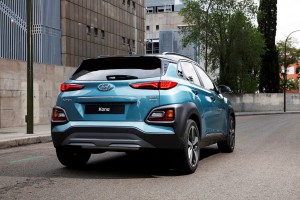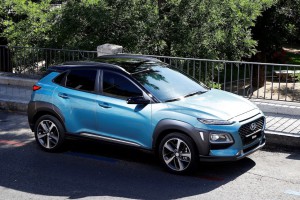After offering up a tease last week of the new compact crossover it will be bringing to the U.S. market later this year, we’re finally getting a full look at the new 2018 Hyundai Kona.
The new ute slots under existing Hyundai SUVs, the Santa Fe and Tucson, to target one of the world’s fastest-growing vehicle segments – taking aim at such offerings as the new Nissan Rogue Sport, the Honda HR-V and Toyota C-HR. It could prove a critical move for Hyundai, which has found itself short of SUV models even as U.S. buyers by the millions switch from sedans and coupes to utes.
“Even as the global SUV market is nearing saturation, we believe that extra small or small SUVs have more room for growth than large SUVs,” said Hyundai Motor Co Vice Chairman Chung Eui-sun said during the unveiling of the Kona in Seoul on Tuesday.
The new model picks up on the larger new hexagonal grille design seen on the latest Elantra GT and Sonata, which Hyundai calls “our new family identity.” The headlight arrangement, if anything, is reminiscent of the Jeep Cherokee, with the daytime running lights in thin strips flanking the upper grille and its more traditionally shaped headlamps placed mid-nose.
(Hyundai offered an early look at the Kona recently. Click Here for the story.)
From the side Kona gets the sort of black cladding around the wheel wells that manufacturers love to use to signal the ruggedness of their crossover models. The hood and side sheet metal reveal significant sculptural details, including a rising feature line that flares off of the front wheel wells to flow all the way to the Kona’s taillamps.
The back end is reminiscent of the Tucson with the taillights also split into upper and lower clusters.
As with the current Santa Fe and Tucson models, the Hyundai Kona is a car-based crossover, rather than a truck-based SUV, sharing its underpinnings with the current Accent, the maker’s subcompact sedan notably being redesigned for the upcoming model-year.
The interior, Hyundai claims, will offer best-in-class roominess. Credit, in part, a creative layout for the all-wheel-drive system meant to minimize interior intrusion and to permit a flat load floor.
(Click Here to see TDB’s first drive in the new Hyundai Ioniq hybrid.)
While the cabin boasts a fairly simple layout it offers some high-tech features likely to appeal to the youthful buyers that are moving into this segment. Depending upon the market and the vehicle grade, there will be infotainment displays ranging from five to eight inches. And the Hyundai Kona will features such niceties as Apple CarPlay and Android Auto, a rear camera, a head-up display and wireless smartphone charging.

The Kona’s exterior hints at the future design direction of Hyundai Motor’s next generation of SUV models.
Safety features will include rear cross-traffic alert, blind-spot monitoring, lane-keep assist and forward-collision avoidance. The last system falls short of the Automatic Emergency Braking technology that some makers are adding, however. That includes Nissan which just announced plans to double the number of vehicles it will sell in the U.S. next year equipped with AEB.
In terms of powertrains, Hyundai plans to offer a variety of different options worldwide, with the U.S. to get both a 147 horsepower 2.0-liter inline four mated to a six-speed automatic, and a 175 hp turbocharged 1.6-liter inline-four that will be one of the quicker offerings in the segment, rated at 7.7 second 0 to 100 kmh (or 0 to 62.5 mph).
The arrival of the Hyundai Kona could prove critical for the Korean carmaker. After years of steady sales gains, demanded has been faltering of late – a key reason why the maker appeared to have ousted CEO Dave Zuchowski earlier this year. But, in reality, analysts have said, he had little chance of rebuilding momentum until Hyundai expanded its limited SUV range.
(To see more about Hyundai closing a possible opening for hackers, Click Here.)
“Our sales plan has suffered a setback, but we will use this (new model) as an opportunity to overhaul our products,” said Chung.



A Hyundai Escape.
Juke Sport? Do you mean Rogue Sport?
Yep, and thanks for the catch…